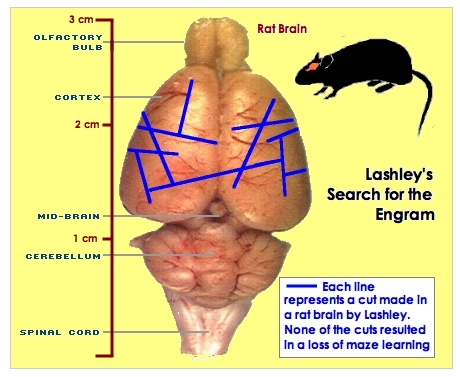|
|
PSY 340 Brain and Behavior Class 32 Learning, Memory, and Memory Loss [OUTLINE] |
|
|
|
PSY 340 Brain and Behavior Class 32 Learning, Memory, and Memory Loss [OUTLINE] |
|
I. Localized Representations in Memory
- Ivan Pavlov developed the theory of classical conditioning
- B. F. Skinner developed the theory of operant condition which said that we are either reinforced or punished by the environment for the behaviors we do
- Where is the learning? There is no doubt that both theories are right insofar as we do learn from the environment and our experiences.
- But, where does that learning wind up in the brain?
- Where is the actual physical connection between what we did and what happened to us?
- Where is that memory about the speeding ticket which prompts us to slow down ten years after getting it in the first place?
Karl Lashley's FAILED Search for the Engram

In the period from roughly 1920 to 1955, Lashley searched after the "engram"Cortical Cuts
Tissue Ablation
Lashley's Principles for the Nervous System. Lashley rejected the notion of localized learning.
- Equipotentiality: All parts of the cortex contribute equally to learning; one part can substitute for another part.
- Mass Action: The cortex works as a whole; performance improves when more of the cortex is involved.
We know that Lashley was wrong. Why? He assumed (1) the engram (memory trace) is only in the cortex and (2) all memories are the same physiologically.
Modern Search for the Engram
Conditioning & the Lateral Pontine Nucleus of the Cerebellum
- Rabbit eyes will blink (= UR: unconditioned response) if a puff of air hits them (= US: unconditioned stimulus).
- Richard F. Thompson conditioned rabbits using a tone (= CS: conditioned stimulus) which he paired with the US. Eventually, the rabbits learned to blink (= CR: conditioned response) when they heard the CS alone.
- Learning the CS:CR connection increased the activity level of the lateral pontine nucleus (LPN; called the lateral interpositus nucleus in the text) of the cerebellum.
- Conclusion: Learning seems to have taken place at the Lateral Pontine Nucleus. Further, this and other research points to conditioned learning in the cerebellum.
II. Types of Memory
Short- and Long-Term Memory
Donald O. Hebb proposed in the late 1940s a model of memory with two different components:
- short-term memory (STM; up to 20 seconds)
- rehearsal
- George Miller noted, the storage capacity of STM is limited: 7 +/- 2 chunks of information
- long-term memory (LTM; 20-60 seconds to a lifetime): anything that happened in the past which you can remember
- Brain consolidates memories by means of a reverberating circuit within the nervous system; gradually causes some type of permanent change in the chemical or structural make-up of the nervous system.
Changing Views of Consolidation
- Time for consolidation varies considerably
- Memories are labile (changeable or vulnerable to alteration). When memories are recalled, they are frequently reconsolidated
Alan Baddeley's "Working Memory" (WM): A Modern Advance
- phonological rehearsal loop: auditory & linguistic information
- visuospatial sketch pad
- episodic buffer
- central executive control system
Testing the "working memory" model uses delayed response tasks = respond to a stimulus that was seen or heard a short time ago with a time delay inserted between the perception and the response.
• dorsolateral prefrontal cortex as site for rehearsed memory. The rest of the prefrontal cortex is also involved in WM.
III. Memory Loss (Amnesia)
A. Korsakoff's Syndrome & Other Prefrontal Damage
Wernicke's encephalopathy
• deficiency of thiamine (vitamin B-1).
• 80% of patients surviving Wernicke's encephalopathy develop Korsakoff's Syndrome (KS).KS is a chronic brain disorder characterized by severe memory problems: both anterograde and retrograde memory is usually damaged. Patients also show apathy and confusion.
The brain area damaged includes the mammillary bodies (beneath the hypothalamus) and the dorosmedial (or mediodorsal) thalamus (nucleus connected to pre-frontal cortex).
Patients with KS often show
- Confabulation
- Chronological reasoning difficulties: For example: Mary had a baby when she was in college. It has been ten years since Mary first went to college. Is Mary's child older or younger than 10 years of age?
- Better new implicit than explicit memory due to the effects of priming
B. Alzheimer's Disease (AD)